Phylum Rotifera - PowerPoint PPT Presentation
1 / 13
Title:
Phylum Rotifera
Description:
'Toes' with pedal glands for adhesion. Corona - cilia ring. ... Size aids in diffusion of gas and nutrients. Protonephridia with flame bulbs. ... – PowerPoint PPT presentation
Number of Views:1073
Avg rating:3.0/5.0
Title: Phylum Rotifera
1
Phylum Rotifera
2
Phylum Rotifera
Pseudocoelomate - coelom is remnant of blastocoel
and not completely surrounded by
mesoderm. Advantages of coeloms.
3
What do rotifers look like?
Jointed cuticle. Telescoping foot. Toes with
pedal glands for adhesion. Corona - cilia ring.
4
How do rotifers support themselves and move?
Cuticle provides support. Pseudocoelom acts as a
hydrostatic skeleton to protrude body parts (foot
and trochal discs of corona).
5
How do rotifers support themselves and move?
Many swim using coronal cilia.
6
How do rotifers support themselves and move?
Many creep by attaching foot and elongating body
to extend forward. Bands of muscles.
7
How do rotifers support themselves and move?
Cerebral ganglia and longitudinal nerve cords.
Corona has tactile bristles, chemoreceptors, one
ocellus, and antennae.
8
How do rotifers feed themselves?
Variety of feeding methods.
9
How do rotifers feed themselves?
Complete digestive system. Salivary glands and
gastric glands. Mouth, stomach, intestine, anus.
10
How do rotifers circulate nutrients and
osmoregulate?
Pseudocoelom acts as medium for circulation. Size
aids in diffusion of gas and nutrients. Protonephr
idia with flame bulbs. Nephridioduct leads to
bladder which empties in cloaca.
11
How do rotifers reproduce?
Males with simple testis sperm duct and
gonopore. Females produce eggs in ovary and yolk
is added before moving to oviduct and
cloaca. Internal fertilization. Eggs are
encapsulated and deposited on substratum.
12
How do rotifers reproduce?
Asexual reproduction by parthenogenesis
alternates with sexual reproduction. Females
mitotically produce diploid ova (amictic ova)
which develop without fertilization into females.
13
How do rotifers reproduce?
With proper stimulus, some females meiotically
produce haploid eggs (mictic ova) which develop
parthenogenetically into haploid males which
produce sperm by mitosis. These sperm fertilize
mictic ova and produce thick-walled zygotes to
survive extreme conditions. Zygotes hatch into
amictic females when conditions good.































